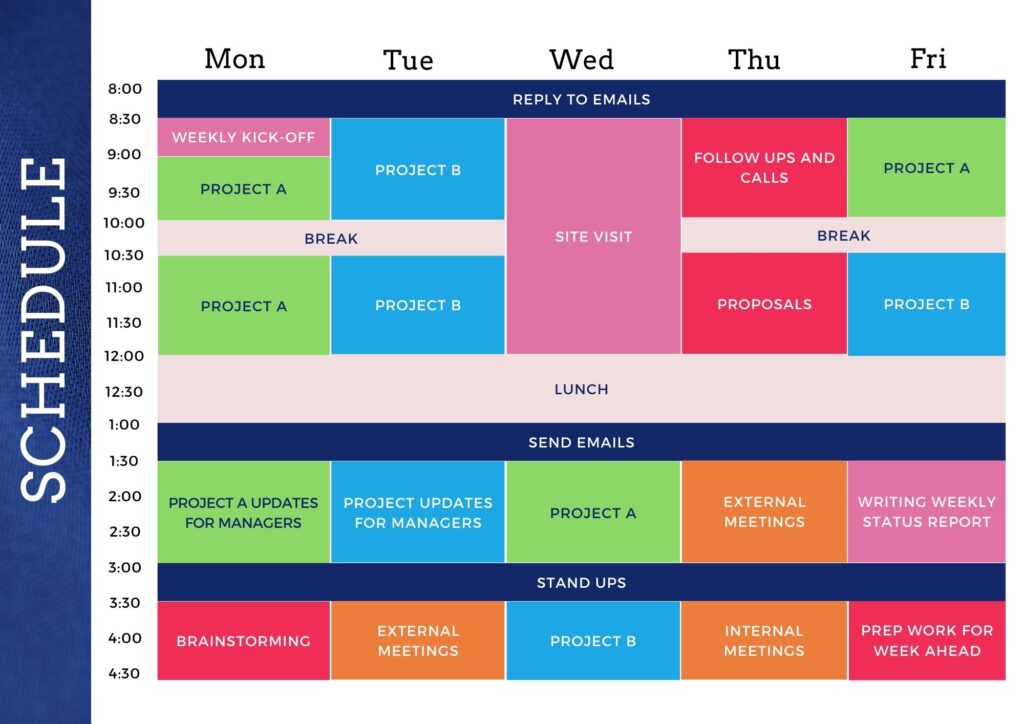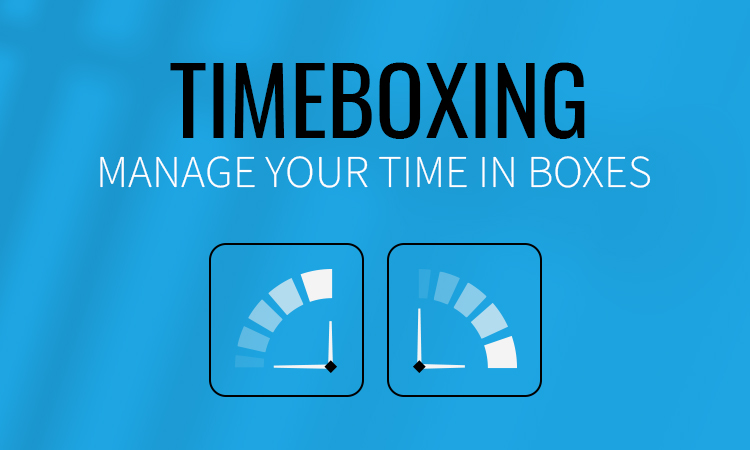In our digital-first world, there are so many things competing for our attention. Notifications, emails, news feeds—there doesn’t seem to be enough hours in a day to deal with them all. If you’re a working professional, these distractions make completing tasks all the more challenging. What’s more, you’re likely not working in a vacuum. Separate projects have different timelines, and making sure everything’s on time can be stressful. Even planning out your route of attack may seem difficult. How exactly does one plan out their time accordingly with so many different deliverables on the table? I present a possible system: timeboxing.
What is Timeboxing?

Basically, it involves splitting your entire day into “boxes,” or periods of time, and working only on the activity assigned for each box.
Timebox Management: What to Know
Keeping a timebox schedule is easy. You simply take the calendar you’re already using (it can be virtual or physical) and segment it into time periods for specific activities. An activity makes it into a box if it has a goal, deliverables, and measurable results.
Activities could be milestones, tasks that help you work towards a larger goal. Different activities would also require different amounts of time, so some boxes could be larger than others.
For example, let’s take the start of a workday. You can box in two hours in the morning for working on the week’s top priority, another two hours after that for your second top deliverable, and then box in 30 minutes to 1 hour for lunch.
As you make your way through the day, stick to your planned activities per box. Only switch to the next task once you’ve completed everything you need to do for the current box.
Maximizing your Timebox Schedule
Timebox management sounds really simple (and maybe even like common sense) on paper. However, accurate and efficient timeboxing requires not just foresight in planning, but also self-control to remain on task.
Simply laying out boxes of time on your calendar won’t make you a master of organization and productivity. Becoming an expert timeboxing planner means knowing your priorities and delegating enough hours in a day to each. We’re in a hyperconnected world, and it’s becoming increasingly difficult to sit for long periods and just concentrate on one thing. Timeboxed schedules require you to do just that.
Additionally, timeboxing definitely isn’t for everyone. There are many different systems for time management, and they rely on different methods to remain useful. Besides explaining the important considerations to approach timeboxing, I’ll also go over the qualities of someone who can use this system to its full potential.
Benefits of Timeboxing
Before I go into what you need to think about before you decide whether or not to timebox, I’ll present some of timeboxing’s biggest benefits.
First and foremost, like you would expect from a time management system, it does wonders for your productivity. It allows you to slow down and plan out your day beforehand. This allows you to separate your timelines for each piece of work accurately.
 Additionally, by separating time, you give yourself a structured way to tackle projects that may otherwise be very nebulous. It can seem daunting just looking at a project in its entirety. Luckily, timeboxing forces you to slow down and break every task into digestible, approachable steps.
Additionally, by separating time, you give yourself a structured way to tackle projects that may otherwise be very nebulous. It can seem daunting just looking at a project in its entirety. Luckily, timeboxing forces you to slow down and break every task into digestible, approachable steps.
Besides that, you can use timeboxing to separate times out not just for work, but also for rest! Allocating time towards non-work tasks and being able to fully relax into them is a better feeling than you may think.
Finally, it keeps you accountable! At the very end of the fixed time period, you’ll have the opportunity to gauge your productivity. This is usually done through how much work you’ve actually finished within that period of time.
If you’re not reaching your goals, it may be time to adjust your goals. Or, maybe you should adjust your habits. Being able to analyze the breakdown of the work you’ve done is one of timeboxing’s greatest benefits.
What Makes Timeboxing Unique?
Now, these benefits are all amazing. However, there are definitely important things to consider before you enthusiastically begin to implement this.
First and foremost, I want to explain a bit more about what exactly makes timeboxing a unique system. If it is really splitting time for certain tasks, it may seem like a relatively generic methodology. However, to timebox accurately, you will definitely need to keep some constraints in mind
For example, timeboxing is meant to help you specifically set aside time for tasks that you can’t seem to get excited about. Once you set aside a time box for a project, it is theoretically impossible to procrastinate on it if you follow the system.
On the other hand, it’s also a strong system for tackling projects that you fear may take up too much of your time, such as cleaning up emails, which may drag itself out. By setting a strict deadline for your work, you force yourself to be efficient and finish it quickly. If you want to timebox accurately, you need to have a clear understanding of what tasks fall under what category. Then, you can segment time accordingly.
Isn’t Timeboxing Just Goal Setting?

Additionally, timeboxing is different from simply time managing because of its emphasis on deadlines and goals. For each box, you not only set a project, but also a goal you want to reach within that project. This way, you enter every timebox with an understanding of where you want to reach. This is a crucial step for timeboxing, so make sure you don’t neglect a pre-task analysis of actually figuring out a goal.
Timeboxing is also very structured, and it is unique because of the layers you can add to your boxes. For instance, if you’re setting aside a timebox for a specific project, you can further split that time into two separate tasks for the project. This makes each box further divisible, adding to the different ways you can push yourself to do work.
Why Timeboxing is Perfect for Remote or Hybrid Teams
Have a remote or hybrid team? Timeboxing is perfect for you! Since your team members are scattered across different locations, your business hours are most likely overlapping but distinct. When you have dedicated activities per time box, scheduling collaborations and meetings will be easier for you. If your entire team is using timeboxing, even better! You’ll know what people are likely working on at any given moment.
To succeed with timeboxing across a remote team, you all need to be aware of each other’s goals. Though knowing each other’s schedules is not a priority, you’ll be much more efficient if you’re aware of what occupies your teammates during most of their workday. One way to ensure that you’re aware of your teammates’ priorities is by holding weekly team meetings. In these meetings, you can provide each other with status updates on your projects, request for help, and figure out how your schedules can align in a way that works for everyone.
How to Make Timeboxing Work
Of course, before you actually try out timeboxing, we do have some other key aspects that you should know. We at Wing understand that timeboxing can be deceivingly complex. Here are some further tips to consider before approaching this system.
1. Understand your work style
Firstly, you will definitely need to develop a strong sense of your own work ethic and work pace. Timeboxing well starts with setting your time and your goals, and if you always overshoot or undershoot you may start blurring the lines. Of course, it doesn’t need to be perfect math every time, but being open to adjusting your timeboxes is important for success. Understanding how you produce top-quality work is the first step to maximizing timeboxing. For example, do you need frequent breaks, or prefer long, uninterrupted hours? Do you need to bounce ideas off of others, or do you generate your best ideas when thinking alone?
Many people have also realized that their work habits have changed because of the COVID-19 lockdowns. Whether you’re someone who needs a midafternoon walk around the block to jog your creativity, or you can’t start the day without having read and replied to the most urgent emails in your inbox, you need to factor these changes in as well.
2. Use the right tools for timeboxing
Secondly, you have to find the right tools for timeboxing. Obviously, the first step is to consider what calendar you’ll use for this system. Google Calendar is an obvious, virtual choice, but you can also utilize planner notebooks or print-out calendars if you’re more of a physical person. There’s no right or wrong answer here, just focus on what you personally like.
There are other tools that are equally as important as your calendar, however. For example, you’ll definitely want some way of tracking your productivity across the different time boxes, which can give you very unique insights into how you work at certain stages. When you’re working in remote teams, using project management and productivity tools will also keep you on task. Using timeboxing together with these tools will make you that much more productive.
3. Use tools and techniques to focus your attention
Additionally, you should consider investing in some sort of distraction blocker, especially if you want to put in 100% effort during the boxes you should be working on. Luckily, we’ve got you covered! Read our article on possible extensions for blocking distracting sites.
Beyond apps and extensions, you can also enlist the help of people around you. If you work from home, letting your housemates know about your timeboxed work schedule could help you hold yourself accountable for deadlines and activities you should be completing. If you prefer to work at a café or coworking space, don’t worry. It’s still possible to uphold self-imposed deadlines. Arguably, it’s even easier to complete work in these spaces, since establishments like these typically allow patrons to stay for a limited number of hours only.
Risks of Timeboxing
Of course, timeboxing isn’t for everybody. Before you begin trying this system, you should analyze your own characteristics to see if you’re the type of person who can use timeboxing successfully.
Timeboxing requires you to have quite strong foresight. You have to understand your own productivity extremely well in order to divide your time among tasks wisely. If you set aside too much time, you’re not exactly solving the issue. After all, according to Parkinson’s Law, work expands to fill the time you’ve allotted. Giving yourself too much time is still being inefficient.
Besides understanding how well you can use your time, you also need to assess your distractibility. If you have utmost faith in yourself to follow your time boxes to a tee, then you may be well built for this. However, many people have difficulty in intensely structured deadlines like this.

For instance, some people get into a “flow” when they’re working, and may find themselves hard-pressed to completely stop what they’re doing on the dot to move onto another project. If they do switch over, they may be sluggish or even disinterested. For people more used to a “flow” of work, timeboxing may be way too structured. Other systems of time management may work a little better.
Timeboxing also requires you to honestly take feedback and incorporate it. If you see yourself not achieving your goals in a box, being stubborn is the least effective solution. Instead, being able to frankly analyze how well you’re meeting your goals and deadlines is key to successful timeboxing, so you have to be someone willing to self-criticize and self-monitor.
Key Takeaways and Next Steps
While I listed out these potential risks of timeboxing and all the considerations to take into account, I believe that timeboxing is one of the most useful systems out there to effectively manage your time.
Even if you don’t personally know if it is right for you, I urge you to try it. To dip your toes in, you could give yourself a test run at timeboxing. For instance, you could block off a couple boxes in a day to see how well you perform!
Also, keep reading our blog for more tips on productivity, personal growth, and time management!

Roland Polzin is a co-founder and the CMO at Wing Assistant, a product-driven managed B2B marketplace connecting SMEs with vetted talent and making delegation efficient and secure. In 2020 he received his MBA from The Paul Merage School of Business at UC Irvine, and in the same year, he and his fellow Wing co-founders joined the Skydeck Accelerator at UC Berkeley. Previously, Roland served in the German Army as Chief PR Officer.






